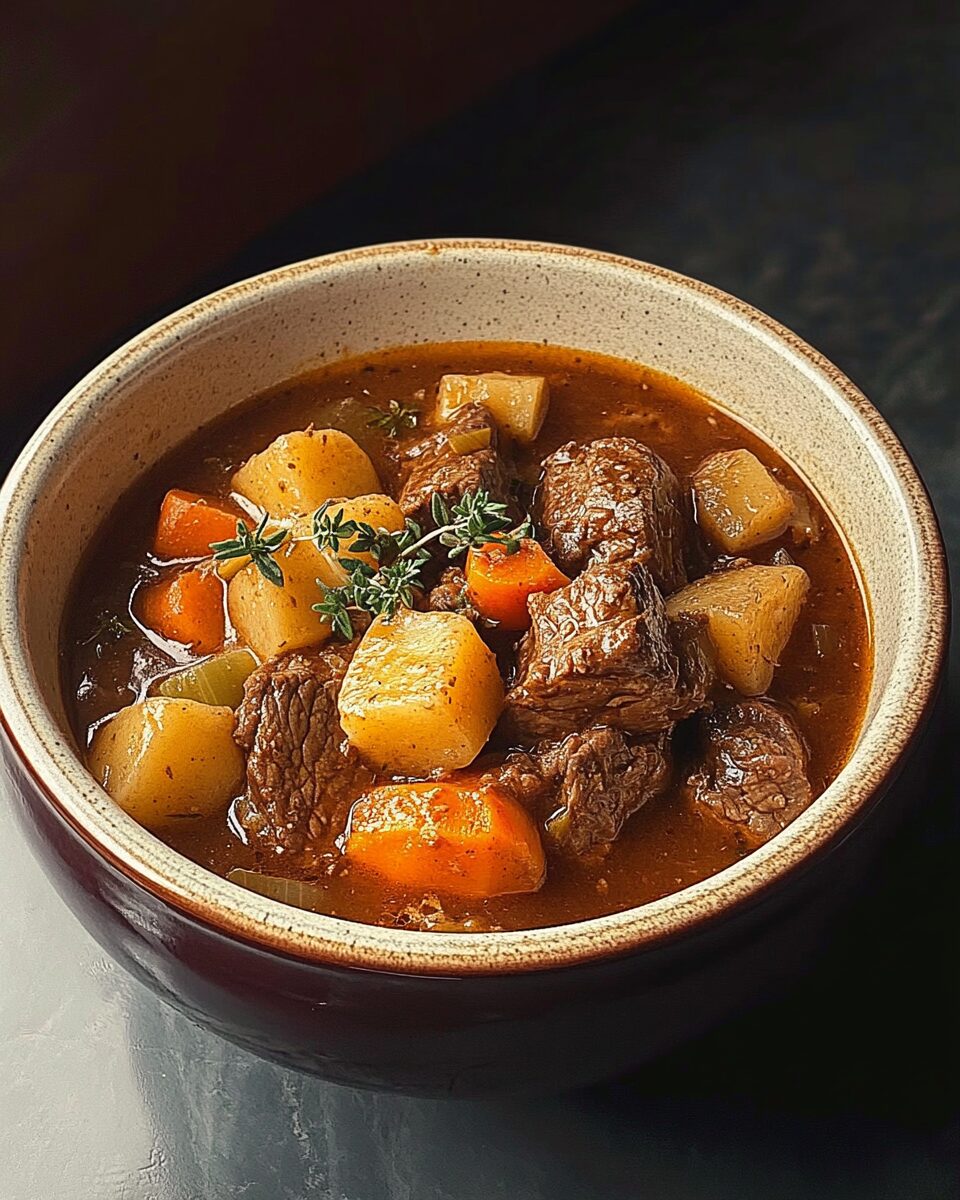This Classic Homemade Beef Stew is the ultimate one-pot comfort meal—rich, hearty, and packed with tender beef, chunky potatoes, and sweet carrots. Simmered in a savory broth with aromatic herbs, garlic, and tomato paste, it’s a satisfying dish perfect for cold evenings or Sunday dinners. Whether prepared on the stovetop, in the oven, slow cooker, or Instant Pot, this recipe delivers melt-in-your-mouth beef and deep, robust flavors in every spoonful.
Full Recipe:
Ingredients
-
2 lbs beef chuck roast, cut into 2-inch chunks, excess fat removed
-
1 tsp kosher salt
-
½ tsp coarsely ground black pepper
-
2 tbsp gluten-free all-purpose flour (or whole wheat flour)
-
2 tbsp olive oil (or avocado oil)
-
½ yellow onion, chopped
-
4 garlic cloves, minced
-
1 large carrot (or 2 medium), cut into 2-inch chunks
-
2 Yukon gold potatoes, diced into 2-inch pieces
-
2 cups beef broth
-
¼ cup tomato paste
-
1 tbsp Worcestershire sauce
-
1 bay leaf
-
2 tsp fresh thyme leaves (for garnish)
Directions
Step 1: Preheat the Oven
Preheat to 325°F (163°C).
Step 2: Prep and Brown the Beef
Season beef with salt and pepper, then coat with flour. In a Dutch oven, heat oil and brown beef in batches for 3–4 minutes per side. Set aside.
Step 3: Sauté Aromatics
Add onion, garlic, and carrot to the pot. Cook for 2–3 minutes until lightly browned.
Step 4: Build the Stew
Add potatoes, broth, tomato paste, bay leaf, thyme, and Worcestershire sauce. Scrape up any browned bits from the pot bottom. Return beef to the pot.
Step 5: Oven Cooking
Cover and bake for 2–2.5 hours, until beef is fork-tender. Remove bay leaf. Adjust salt and pepper if needed.
Optional Cooking Methods:
-
Stovetop: Simmer covered on low for 60–90 minutes.
-
Slow Cooker: Cook on low for 9–10 hours, high for 6–7 hours.
-
Instant Pot: Cook on high pressure for 35 minutes, natural release for 10 minutes.
Optional Thickening:
Mix stew liquid with 1 tbsp cornstarch and stir back into the pot. Simmer until thickened.
Nutrients (Per Serving, Approximate)
-
Calories: 383 kcal
-
Protein: 32g
-
Fat: 22g
-
Saturated Fat: 8g
-
Carbohydrates: 14g
-
Fiber: 3g
-
Sugar: 3g
-
Sodium: 936mg
-
Potassium: 972mg
-
Vitamin A: 2223 IU
-
Vitamin C: 12mg
-
Calcium: 67mg
-
Iron: 6mg
Why This Stew Stands Out
The beauty of this beef stew lies in its simplicity and flexibility. The ingredients are familiar and pantry-friendly, but the results are anything but ordinary. Browning the beef creates deep, meaty flavor, while the tomato paste adds a subtle richness and umami to the broth. The long cooking time gives the connective tissue in the chuck roast time to break down, creating a melt-in-your-mouth texture that’s hard to beat. Each spoonful is packed with tender meat, soft potatoes, sweet carrots, and aromatic herbs, delivering balance and depth in every bite. It’s a dish that invites second servings and nostalgic moments.
The Comfort of One-Pot Meals
One of the biggest perks of beef stew is that it’s a true one-pot meal—everything cooks together, which means fewer dishes and more flavor. The starch from the potatoes slightly thickens the broth, the carrots add sweetness, and the garlic and onions provide the aromatic foundation. As the ingredients simmer together, they infuse the broth with layer upon layer of savory goodness. This makes beef stew an ideal dish for meal prepping or feeding a crowd, and it only gets better with time, tasting even richer the next day.
Flavor and Texture
This stew delivers a flavor profile that is both robust and comforting. The browned beef brings a savory depth, while the broth—enriched with tomato paste and Worcestershire sauce—has a rich umami character with a hint of acidity to balance the hearty ingredients. Fresh thyme and bay leaf lend subtle earthiness and fragrance. Texturally, the dish is all about contrast: the beef is fall-apart tender, the vegetables are fork-soft but not mushy, and the broth is velvety and full-bodied.
Health Benefits
Though rich and hearty, this beef stew includes plenty of nutritional benefits. Beef chuck is a great source of protein, iron, and B vitamins. Carrots provide beta carotene (Vitamin A), potatoes offer potassium and fiber, and garlic and onion bring powerful antioxidant and anti-inflammatory properties. Opting for olive or avocado oil adds healthy fats, and you can control the salt content by choosing low-sodium broth and seasoning to taste. It’s a balanced meal that provides both macro- and micronutrients in a single bowl.
Serving Suggestions
This stew is incredibly satisfying on its own, but a warm slice of crusty bread or a buttery biscuit on the side makes it even better—perfect for soaking up the rich broth. For a lighter meal, pair it with a crisp green salad dressed in vinaigrette or a side of roasted Brussels sprouts. It also pairs well with grains like brown rice or quinoa if you want to stretch the portions further. For a special touch, top with fresh parsley or a sprinkle of Parmesan cheese just before serving.
Cooking Tips
To get the best results, take the time to brown the beef properly—this step adds deep, savory flavor that will carry through the entire dish. Deglazing the pan with broth or wine after browning helps lift all the flavorful bits from the bottom of the pot. Keep your vegetable chunks uniform so they cook evenly. And always check the seasoning near the end—after the long simmer, the flavors can concentrate, and a final adjustment of salt and pepper might be needed. For extra richness, add a small knob of butter at the end, or a splash of red wine for depth.
Ingredient Spotlight: Chuck Roast
Chuck roast is the gold standard for beef stew. Its marbled texture means it’s loaded with connective tissue that turns tender and succulent when slow-cooked. Unlike leaner cuts, it doesn’t dry out with extended simmering—in fact, it improves. If you’re shopping for the best stew meat, look for well-marbled chuck and trim off any excessive surface fat. It’s a budget-friendly option that turns into a luxurious main course with nothing more than time and seasoning.
Common Mistakes to Avoid
One of the most common errors is not browning the beef properly or skipping this step altogether. Don’t overcrowd the pan—cook in batches if needed. Another mistake is overcooking the vegetables to the point of mushiness; add them later if you’re cooking the stew for a long time. Using high heat throughout can toughen the meat—keep it low and slow for tender results. And finally, always taste and adjust—underseasoning is easy to fix, but over-seasoning is harder to correct.
Perfect Pairings
Red wines like Cabernet Sauvignon, Syrah, or Merlot complement the richness of the stew beautifully, while malty beers such as brown ales or stouts also work well. For a non-alcoholic option, consider sipping hot black tea, apple cider, or a sparkling water with lemon. If you’re planning a full meal around it, follow with a simple fruit crisp, apple tart, or chocolate mousse to round things off with a cozy dessert.
Variations to Explore
Feel free to get creative with your beef stew. Add mushrooms for an earthy flavor, or stir in peas during the last 10 minutes for a pop of sweetness and color. For extra heartiness, toss in barley or farro. A splash of red wine or a spoonful of Dijon mustard in the broth adds sophistication. Prefer a spicier kick? Add smoked paprika or a pinch of chili flakes. You can also make it dairy-free, gluten-free, or Whole30 compliant with a few minor substitutions. It’s a versatile canvas ready for personalization.
Conclusion
Classic Homemade Beef Stew is everything a comforting meal should be—warm, nourishing, and soul-satisfying. With its tender beef, hearty vegetables, and deeply savory broth, it’s a dish that brings people together and keeps them coming back for more. Whether served as a Sunday family dinner or a make-ahead weekday staple, this stew proves that simple ingredients and slow cooking can deliver truly spectacular results. With its timeless appeal and customizable nature, beef stew remains a beloved favorite in kitchens across the world. Try it once, and you’ll understand why it has stood the test of time.

